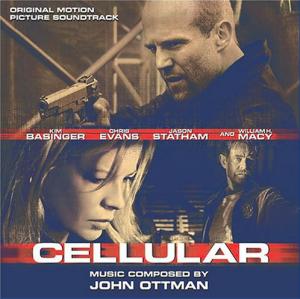Cellular
Music composed by John Ottman
Available on Lalaland Records LLLCD 1025
Running time: 57.43
LaLaLand Records Amazon UK Amazon US

See also: James Newton Howard's Signs
In what seems to be a continuing obsession with phones for Larry (Phone Booth) Cohen, here is a new thriller scripted by the writer director this time concerned with mobile, or as they call them in the U.S., cell phones. Direction is by David R. Ellis (Final Destination 2).
The movie has a powerful cast of Kim Basinger, Chris Evans, William H. Macy and Jason Statham, among others, and tells the story of Jessica Martin (Kim Basinger), a female police officer kidnapped by Greer (Jason Statham), a vicious criminal who has threatened to murder her husband and son if he doesn't get what he wants. Greer destroys the only working telephone in the cabin where she's held, but Jessica manages to put enough of the pieces together to send out a call that's picked up by Ryan (Chris Evans), a college student, on his cellular phone. Jessica manages to convince Ryan of the severity of her situation, but she has no idea of where she's being held, leaving his cell phone as the only link to her whereabouts - and his batteries are starting to wear out.
John (X Men 2) Ottman was chosen as composer, and he manages to add another fresh and interesting new element in the suspense / thriller genre utilizing a large orchestra with a grand and frequently used brass section along with pulsing electronics.
The album opens with 'Opening/Abduction' in a distinct dark mood implying simmering evil. The orchestra accompanies flute arpeggios and general chord progressions which remind us of James Newton Howard's Signs and indeed, that composer's style in general. This leads to the first statement of the main theme by orchestra and piano. It's a quite optimistic melody in contrast with the opening atmosphere. The piece changes in the middle into excellent brass-glissandos and clusters, quick percussion motifs and violent violin lines.
'Going shopping' opens with a great rendition of the main theme along with syncopated brass and percussion rhythms, high-pitched violins that create an odd effect and brass lines that resemble sounds of a phone. All this leads to a spectacular rising of the piece's tempo, mood and volume using modern-orchestrated drums, percussion, electric guitar and mainly brass accompanied by a flawless xylophone with a distinct James Bond-esque feeling to it.
In 'Making a connection' the electric guitar reappears with groovy drum rhythms in the opening to the piece, which then moves with the distinct Signs-like flute melodies. The next piece, 'Freeing Ricky' operates in the same vein but it's more of a tension-building cue, with fine brass glissandos, percussion and deep brass syncopated rhythms. In the end the piece becomes smoother and calmer with some nice piano and string writing.
A real highlight of the score, is the 'School's out' cue, a very dynamic one with intense percussion, electronics, drums, deep and groovy brass lines, playful flutes in the Signs-like lines and a lot of clusters performed by many different instruments. Another important piece is 'The Pier', which while it starts with underscore, towards its middle changes rapidly to deep brass, thunderous percussion and glissandi with a lot of clusters. The main theme reoccurs along with the electronic phone sounds.
'Police Station' is orchestrated along with some beautiful brass glissandos, rapid rhythms, deep brass lines lively percussion and electronics, snap wind instrument lines in a playful writing that can be classified as 'mickey-mousing technique'. Some string lines that loosely remind us of the Jaws' main theme by John Williams appear towards the end.
In the final piece, 'Shoot Out', great percussion work dominates along with continuously ascending and descending string lines with some distinct atonal writing, especially for the violins. It's an exciting, wild piece with clusters and the Jaws-like string motifs that altogether lead to a glorious and victorious restatement of the main theme. Full orchestra with loud brass passages leads to sensitive melodies by the piano and cello. This particular instrument coupling performs a sad and smooth rendition of the main theme and along with the full orchestra they conclude the score in an upbeat and hopeful manner.
Some negative elements – there are several underscore cues which doubtless work well in the film but lead to poor listening experience on cd. They either appear as plain mood passages ('Mooney's curious', 'Fake out' ' Lost Connection/Dirty Cops') or together with some more involving elements like main theme renditions and brass glissandos ('The Bait'), or either as modern-sounding and deep percussion work with some staccato brass lines ('Epiphany/Bank').
In general, Cellular is a rather interesting if not especially memorable score. The unconventional electronic effects which simulate a phone's sounds prove the most brilliant invention by Ottman, who also writes for deep brass and strings in the same way - i.e. resembling a phone's sounds. Also the fascinating glissandos, a lot of clusters, mainly by the brass section and staccato, aggressive, syncopated brass lines and rhythms altogether combine to give the score an amazing sound. Also notable is the impressive percussion (mainly the timpani) and drums work throughout the whole score and the inventive electronics. All these elements elevate the score's quality and importance but in contrast, this score needed more themes, better and more intensive thematic development, longer appearances of the main theme and generally more work to function as an almost hour long CD.
Demetris Christodoulides
31/2
Return to Index